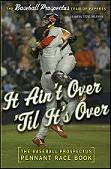This is a continuation of the serialization of "The Great Pennant Race Abstract" from the book It Ain't Over 'Til It's Over: The Baseball Prospectus Pennant Race Book.
One of the three components of our methodology in ranking the races is to consider the number of teams involved. Obviously more teams typically leads both to more fan interest across the country as well as heightened drama.
But what about the greatest two team race? That distinction belongs to the 1942 NL race won by the St. Louis Cardinals. The reason that race scores so highly is because it was so close, being decided by just two games, and both teams easily topped 100 wins with the Cards winning 106 and the Dodgers 104. There was also plenty of drama for good measure. On the morning of August 16th it was the Dodgers, featuring a pair of 23 year olds in Pee Wee Reese and Pete Resier, who held a nine and half game lead over the Cardinals. But the Branch Rickey built Cards, and second youngest team in the league with contributions from rookies Stan Musial in left field and Johnny Beazley on the mound, would go on to win 35 of 41 games and 12 of their final 13 while the Dodgers finished 25-17 to take the pennant and eventually the World Series over the Yankees in five games.
That great Cardinal team, then nicknamed the "St. Louis Swifties", was also interesting in that they led the league in runs scored (4.84 per game, a fact that is often forgotten), batting average, on base percentage, and even slugging percentage despite hitting just 60 homeruns finishing sixth in the eight team league. To make up for their lack of homerun power which saw their infielders hit just 9, the team slugged 69 triples and 282 doubles both of which led the league. Enos Slaughter racked up 17 triples and 31 doubles while 6'2" second sacker Marty Marion hit 38 doubles. Sportsman's Park certainly played as a hitter's park but they also led the league in fewest runs allowed (3.09 per game) by a wide margin led by MVP Mort Cooper who twirled 10 shutouts on his way to 22 wins.
On the other side of the coin the only five team race among the 165 that had positive Race Scores was the 1988 AL East race which ranked 23rd and was won by the Red Sox with a record of 89-73 with the five teams finishing within 3.5 games. This race scored highly despite the victor only garnering 89 wins in part because of the 30% bonus awarded to a five team race.
Team Name G W L PCT GB RS RA
Boston Red Sox 162 89 73 0.549 - 813 689
Detroit Tigers 162 88 74 0.543 1 703 658
Milwaukee Brewers 162 87 75 0.537 2 682 616
Toronto Blue Jays 162 87 75 0.537 2 763 680
New York Yankees 161 85 76 0.528 3.5 772 748
Cleveland Indians 162 78 84 0.481 11 666 731
Baltimore Orioles 161 54 107 0.335 34.5 550 789
The Orioles were out of the race early as losers of their first 21 games shattering the previous record of 13 and the Indians, while briefly in first place in April, soon turned mediocre. It was the Yankees and Tigers who then got hot and occupied the top two spots, 6 games in front of the rest of the pack as July dawned. Over the All-Star break the Red Sox, with a record of 43-42, fired manager John McNamara and promoted coach Joe Morgan (more on managerial changes below). The Sox then started the second half with a 12-game winning streak, picked up Mike Boddicker at the trading deadline to fill out the rotation, and pulled into a tie with the Tigers on September 3rd. From there they built a five game lead by September 23st but then promptly lost seven of their last nine and just barely holding on.
The Tigers were by then the oldest team in the league (more on old teams below) and their offense faded down the stretch as did the Yankees pitching, which was second worst in the league only to Baltimore. The Yankees had a managerial change of their own when Billy Martin, returning to the job for the fifth and final time, was fired in late June when the Yankees slipped from first.
125x125_10off+copy.jpg)


